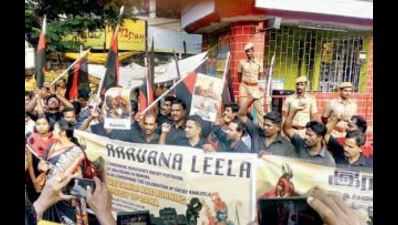- News
- City News
- chennai News
- Reviving Ravanlila to counter ‘racist’ epic
Trending
This story is from October 13, 2016
Reviving Ravanlila to counter ‘racist’ epic

Members of Thanthai Periyar Dravidian Movement organised a Ravanlila by burning effigies of Ram in Royapettah.
In the 1970s, Periyarists conducted Ravanlilas in which they burned the effigies of Ram in response to Ramlilas conducted across the country. Shortly after Periyar E V Ramaswamy’s death, his wife Maniyammai burnt the effigy of Ram at Periyar Thidal in 1974. Periyarists pitched for Ravan saying the Ramayan was not a story of triumph of good over evil but the conquest of Dravidians by Aryans.They said Ravan was a Dravidian king and Ram an Aryan.
After four decades, the city witnessed a similar event on Wednesday. To protest against Ramayan’s portrayal of Dravidians as demons and monkeys, members of the Thanthai Periyar Dravidian Movement (TPDM) organised a Ravanlila by burning the effigies of Ram at Ajantha bus stop in Royapettah. The original plan was to conduct the event opposite Mylapore’s Sanskrit College but police intervened to have it moved.
TPDM volunteers burned four six-foot-long effigies of Ram. “In the northern part of India, people burn the effigies of Ravan. This is a sheer case of racism in which they degrade Dravidians as demons. We had sent letters to the Prime Minister a couple of weeks ago requesting him to stop this practice. But there was no response. That’s why we had to burn the effigies of Ram,” said Tinker Kumaran, secretary of the Chennai chapter of TPDM.
Police arrested 11 people in connection with the event and all have been remanded. Periyarists like Kumaran cite the practice of naming children after Ravan in Tamil Nadu as evidence of the regard Tamils still have for Ravan.
“This contradicts Hindu beliefs based on Valmiki Ramayan. It can be termed anti-national too,” said Mahesh M Vaishya, a retired bank manager. “Millions of Hindus who consider Valmiki Ramayan a sacred rendering will feel hurt. But this issue should be debated peacefully between experts from both sides. The point of debate need not be ‘antinational’,” he said.
Mythical narratives attain cultural and political significance depending on the context, say experts. “One should delink the racial adjectives attached to these mythical characters. If you keep on saying that Ram is Aryan, then it is not going to justify the right and the wrong. The right has to be universal. Identities should be removed,” said Ramu Manivannan, head, department of politics, University of Madras.
Citing a recent incident in which Ravan was recreated as an eagle symbolising Pakistan, Manivannan said, “How do you justify such things? We should not forget that the nation doesn’t belong to one group.”
After four decades, the city witnessed a similar event on Wednesday. To protest against Ramayan’s portrayal of Dravidians as demons and monkeys, members of the Thanthai Periyar Dravidian Movement (TPDM) organised a Ravanlila by burning the effigies of Ram at Ajantha bus stop in Royapettah. The original plan was to conduct the event opposite Mylapore’s Sanskrit College but police intervened to have it moved.
TPDM volunteers burned four six-foot-long effigies of Ram. “In the northern part of India, people burn the effigies of Ravan. This is a sheer case of racism in which they degrade Dravidians as demons. We had sent letters to the Prime Minister a couple of weeks ago requesting him to stop this practice. But there was no response. That’s why we had to burn the effigies of Ram,” said Tinker Kumaran, secretary of the Chennai chapter of TPDM.
Police arrested 11 people in connection with the event and all have been remanded. Periyarists like Kumaran cite the practice of naming children after Ravan in Tamil Nadu as evidence of the regard Tamils still have for Ravan.
Many observers see the event as a political act carried out to forcefully assert a counterview when the BJP is ruling at the centre. They also cite protests in Telangana on Sunday in which protesters carried Ravan’s representation. But, just as in the past, the event has sparked criticism too.
“This contradicts Hindu beliefs based on Valmiki Ramayan. It can be termed anti-national too,” said Mahesh M Vaishya, a retired bank manager. “Millions of Hindus who consider Valmiki Ramayan a sacred rendering will feel hurt. But this issue should be debated peacefully between experts from both sides. The point of debate need not be ‘antinational’,” he said.
Mythical narratives attain cultural and political significance depending on the context, say experts. “One should delink the racial adjectives attached to these mythical characters. If you keep on saying that Ram is Aryan, then it is not going to justify the right and the wrong. The right has to be universal. Identities should be removed,” said Ramu Manivannan, head, department of politics, University of Madras.
Citing a recent incident in which Ravan was recreated as an eagle symbolising Pakistan, Manivannan said, “How do you justify such things? We should not forget that the nation doesn’t belong to one group.”
End of Article
FOLLOW US ON SOCIAL MEDIA










